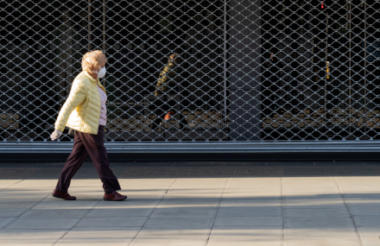For many charities, the past two months have been an exceptionally busy and worrying time. Many organisations have seen explosions in demand – the Trussell Trust reported an 81% increase in demand at foodbanks and the Samaritans saw a 25% increase in calls the first week of lockdown.
At the same time, financial challenges for the sector are acute. But in many ways, this stage of the crisis is straightforward: people need to be fed, they need to be reassured, they need to be kept safe and we need to find resources to meet these needs.
As we begin to think about the end of lockdown, a whole new set of challenges emerge. How do you support an elderly person to use a bus again after a period of months when they have barely left their chair? Will we have a section of society too anxious to leave their homes for years? How do we reach them? How do we support those traumatised by lockdown, whether it is children who have been confined at home witnessing domestic abuse or those working in hospitals and care homes?
Two phases of the response
There are two phases to our sector’s response to coronavirus: the first emergency response and the second recovery response. While mutual aid has been the defining – and heartening – feature of the first wave, the challenges of the second wave are more complex, requiring innovation, leadership and resource.
We’re reaching regularly to the World Wars as parallels for our current situation. In this case, the parallel to the voluntary sector role in the UK during and after the First World War is illuminating.
Charitable donations peaked during the war, and 18,000 charities were established in the UK. The period also saw heroic efforts of individual fundraisers, as we see now. Jennie Jackson was the Captain Tom Moore of the conflict: an eight-year-old from Burnley, she became known as ‘Little Kitchener’ (the Secretary of State for War was Lord Kitchener) and toured pubs, clubs and factories in army uniform collecting donations.
A director general of voluntary organisations was appointed during the war, with a role coordinating and distributing donations to the front, a function similar to that undertaken during the pandemic by many local authorities.
The voluntary sector response as servicemen returned home after World War One – two million of whom had disabilities - provide some interesting lessons for the next stage of our current crisis and some lessons we need to learn as a sector.
Second stage will last a generation
The first lesson is that the second stage response by the voluntary sector will last a generation.
Voluntary associations sprang up following the war tailored to the needs of former servicemen. They focused on rehabilitating servicemen and supporting their independence, innovating in a wide range of areas and laying the foundation for the modern disability movement.
Demand for their services far outstripped capacity. Suffering and despair among former servicemen was widespread: in 1928 and 1929 8,000 ex-serviceman were recorded as committing suicide.
We need to develop new expertise
We face the similar challenges with our recovery stage. The voluntary sector will need to develop new expertise, potentially drawing on approaches used in post-conflict societies and working with people who have experienced trauma.
Thought will need to be given to an extensive reablement programme, both for older people who may have lost mobility during lockdown but also to those who will find it hard to re-enter society due to anxiety.
We will not keep up with demand, with funding as it currently is. There are three potential solutions: accept unmet demand, and the suffering this represents, secure a post-coronavirus financial settlement for the sector or embrace innovation in a way the sector has not done in recent memory.
We need to redouble our efforts to influence the welfare system
The second lesson is for government, but which we as a sector must use our campaigning power to achieve.
A running sore after the First World War was the level of servicemen’s pensions. They were too low to support a family. This is the moment when we need to redouble our efforts as a sector to influence the welfare system.
The five-week wait for Universal Credit (UC) throws many families into debt from which they cannot recover. The level of UC should also be increased to make up for the years in which it was frozen. At a stroke that would lessen the stresses on families and lower demand for voluntary sector services.
We’re going to see high unemployment for years and so setting benefits at a punitive rate to encourage re-entry to the job markets is a pointless policy exercise.
Ensure we give voice to those affected
The third lesson is about how we work with people whose lives have been turned upside down by the pandemic.
In accounts of post-war voluntary action, the cynicism and mistrust of serviceman is often commented on. This was directed at the government and the army, but also at voluntary organisations, which often still fell back on Victorian paternalism in delivering services, for example switching off lifts at a rehabilitation centre at 10.30pm to force servicemen using wheelchairs to respect a curfew.
In the second phase of our response to coronavirus, we’re going to encounter this mistrust. We’re already seeing this in responses to government measures to end lockdown. We need to ensure we’re the sector which can truly give voice to those affected by the pandemic and a sector which those most affected by this pandemic know they can always trust.
Jennifer Allott is chief 0fficer at Age UK York and was previously head of Citizen's Advice Universal Credit support service
Related articles












